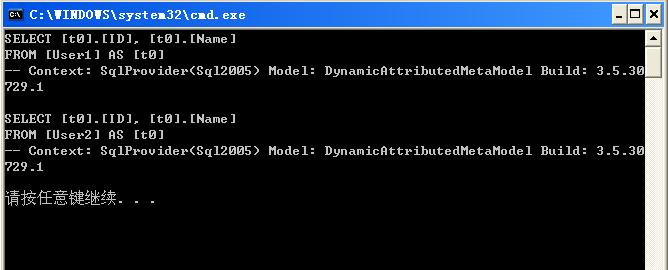提出問題
前段時間,在博客園裡看到有位朋友,問如何實現在動態表名。我們都知道,把一個實體類映謝到表 裡,應該這樣寫:
[Table(Name = "User")]
class User
{
[Column]
public int ID;
[Column]
public string Name;
}
很明顯,這裡的表名是寫死的,有些時候,我們可能要根據不同的情況實現不同的表名 裡加個前綴或者後綴,例如:
tt_User,aa_User,User1、User2。
分析問題
要解決這個問題,首先我們就要明白一個問題,DataContext是如何將實體到表的映射的,事實上,它 是例用MappingSource提供的信息來進行映射的。要解決上面的問題,我就是需要重新構一個繼承於 MappingSource的類。
解決問題
代碼如下:
using System;
using System.Collections.Generic;
using System.Data.Linq;
using System.Data.Linq.Mapping;
using System.Diagnostics;
using System.Globalization;
using System.Linq;
using System.Reflection;
using System.Text;
using System.Xml.Schema;
namespace ALinq.Mapping
{
class DynamicMappingSource : MappingSource
{
class DynamicAttributedMetaModel : MetaModel
{
private MetaModel source;
private const string TypeName =
"System.Data.Linq.Mapping.AttributedMetaModel";
private DynamicMappingSource mappingSource;
internal DynamicAttributedMetaModel(MappingSource mappingSource, Type
contextType)
{
this.mappingSource = (DynamicMappingSource)mappingSource;
var bf = BindingFlags.NonPublic | BindingFlags.Instance |
BindingFlags.CreateInstance;
var args = new object[] { mappingSource, contextType };
source = typeof(DataContext).Assembly.CreateInstance(TypeName, false, bf,
null,
args, CultureInfo.CurrentCulture, null)
as MetaModel;
Debug.Assert(source != null);
}
public override MetaTable GetTable(Type rowType)
{
if (mappingSource.GetMetaTableName != null)
{
var typeName = "System.Data.Linq.Mapping.AttributedMetaTable";
var bf = BindingFlags.NonPublic | BindingFlags.Instance |
BindingFlags.CreateInstance;
var attribute = new TableAttribute { Name =
mappingSource.GetMetaTableName(rowType) };
var args = new object[] { source, attribute, rowType };
var metaTable = typeof(DataContext).Assembly.CreateInstance(typeName,
false, bf, null,
args, CultureInfo.CurrentCulture,
null) as MetaTable;
return metaTable;
}
return source.GetTable(rowType);
}
public override MetaFunction GetFunction(MethodInfo method)
{
return source.GetFunction(method);
}
public override IEnumerable<MetaTable> GetTables()
{
return source.GetTables();
}
public override IEnumerable<MetaFunction> GetFunctions()
{
return source.GetFunctions();
}
public override MetaType GetMetaType(Type type)
{
return source.GetMetaType(type);
}
public override MappingSource MappingSource
{
get { return source.MappingSource; }
}
public override Type ContextType
{
get { return source.ContextType; }
}
public override string DatabaseName
{
get { return source.DatabaseName; }
}
public override Type ProviderType
{
get { return source.ProviderType; }
}
}
public Func<Type, string> GetMetaTableName;
protected override MetaModel CreateModel(Type dataContextType)
{
if (dataContextType == null)
{
throw new ArgumentNullException("dataContextType");
}
return new DynamicAttributedMetaModel(this, dataContextType);
}
}
[Table(Name = "User")]
class User
{
[Column]
public int ID;
[Column]
public string Name;
}
class Program
{
static void Main(string[] args)
{
var mappingSource = new DynamicMappingSource();
int i = 0;
mappingSource.GetMetaTableName = delegate(Type type)
{
var att = type.GetCustomAttributes
(typeof(TableAttribute), true).Single()
as TableAttribute;
Debug.Assert(att != null);
return att.Name + i;
};
var constr = @"Data Source=NOTEBOOK\SQLEXPRESS;Initial
Catalog=DemoDataContext;Integrated Security=True";
var context = new DataContext(constr, mappingSource) { Log = Console.Out };
i = 1;
context.GetTable<User>().Select(o => o).ToList();
i = 2;
context.GetTable<User>().Select(o => o).ToList();
}
}
}
把運行後的結果給大家看一下:

從上圖可以看到,表名已經由原來的User分別變為了User1和User2。